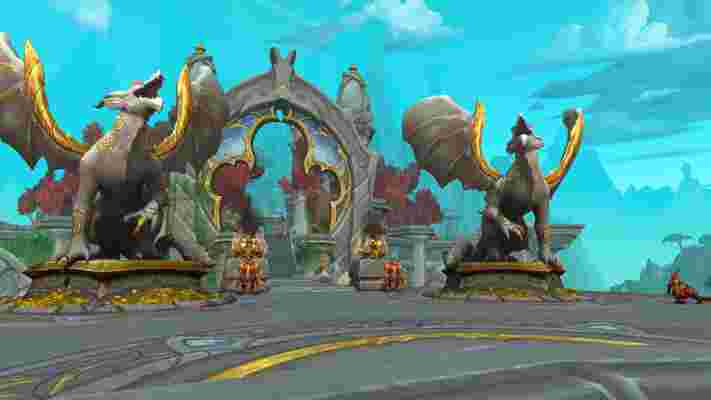Blizzard’s announced its long-awaited 10.0 expansion, Dragonflight. Following scores of rumors, theories, and outright leaks, the developer’s confirmed that for World of Warcraft’s ninth expansion, we’ll be heading to the mythical Dragon Isles, a landmass lost to Azeroth for 10,000 years.
Dragonflight introduces the first race-class combo - the Dracthyr Evoker and a new method of traversing the skies of Azeroth - dragonriding. But the expansion isn’t only adding new toys, it brings a much-needed overhaul to World of Warcraft’s ancient systems. Progression will be revamped, with a new talent system designed to replace recent expansions' weathered ‘borrowed power’ approach; a crafting rework gives gathering and production skills some much-needed love; and a full HUD update, the first in World of Warcraft’s 18-year history, sees the MMOs UI brought up to modern standards.
Here be dragons
The Dragon Isles are a place of primordial wonder, focusing on elemental forces, ancient secrets, and the prismatic dragonflights we’ve encountered throughout World of Warcraft’s long history. Game director Ion Hazzikostas says the new continent is one of the largest landmasses the development team has ever created.
Tucked away in the northeast of Azeroth, the Dragon Isles were inaccessible for 10,000 years. Naturally, then, there’s a focus on exploration in this expansion – you’ll be making contact with races that have been undisturbed by outsiders for generations. Native Centaur, Gnolls, and Tuskarr all feature, as well as a new race of recently awoken elemental half-giants called Djaradin, whose animosity towards dragons will play into the story.

The Dragon Isles are home to four new zones: the Waking Shores, the Azure Span, Thaldraszus - home to the expansion hub city of Valdrakken - and the Ohn’ahran Plains, a location so large the team had to increase the game’s draw distance so you can experience its full, rolling vistas. The new landmass features diverse environments dotted with icy wastes, lush green land, volcanic crags, and sandy shores.
The stakes will be lower in this expansion, Hazzikostas tells us. There isn’t a grand threat to Azeroth in Dragonflight; instead, like in Mists of Pandaria, this is a story of discovery. We’re journeying to the isles not to combat a big-bad box-art boss but rather because the dragons have requested our aid. Hazzikostas confirms fan-favorite characters such as Khadgar, Tyrande, and Wrathion will feature.
We be dragons
It would be a poor dragon expansion if we couldn’t play as one. Announced as a ‘hero class’ akin to Death Knights and Demon Hunters, the new Dracthyr race begins at level 58 on a unique starting zone found off the shores of the Dragon Isles. They’re a bipedal race of dragon-humanoid hybrids with two forms, a more traditional draconid form and a ‘visage’ form that more closely resembles elves and men.

Dracthyr are locked to the new Evoker class, which features both a damage-dealing and healer spec, utilizing the fantasy and aesthetic of Warcraft’s prismatic dragonflights when casting spells. They’re the first class to feature the ‘empower’ ability to charge up spells for extra clout and can cast while briefly flying to traverse the battlefield. Hazzikostas describes the class as akin to a ranged variant of Legion’s Demon Hunter, focusing on mobility in combat.
Both the humanoid and dragon forms of Dracthyr will take advantage of World of Warcraft’s latest advances in character customization, with tweakable jewelry, horns, scales, hair (including ombré color fades), and more.
In the past, Blizzard has struggled with how armor should look on its more bestial races, such as worgen or tauren, but the team may have solved that problem. “In their humanoid visage forms, you’ll be able to wear the full set of armor that you normally would,” Hazzikostas says. “And unlike the worgen, who cannot be in their human form during combat, we are looking for players to showcase their humanoid forms during combat.
“Though, of course, abilities like a deep breath or a wing buffet will require that you are in your draconic form. We do want to allow for some armor carry-over, though yes, fitting a helm on the head of the dragon is not likely to happen. Something like shoulder pieces or having that direct carry-over is much more likely, and something the team is actively working on right now.”

Dracthyr will be available early in the Dragonflight pre-patch with pre-purchase of the expansion, and you will choose at their creation whether to be Horde or Alliance, though unlike Pandarans choosing their faction for story reasons, Dracthyr players will simply encounter that faction first based on their choice.
Traversing the isles
In Dragonflight, the team is dragonriding, a new form of flying that will be constrained to the Dragon Isles, at least initially. You’ll be able to level up its power, like a skill, over the course of the expansion.
Rather than World of Warcraft’s traditional flying, in which players listlessly hover towards their destination, dragonriding has a focus on momentum and gravity. It also lets you crack out rolls, spirals, and velocity changes as you soar through the skies. Hazzikostas says that the current design the team is looking at is limited by a stamina bar, which you can upgrade as you progress.
Early in the expansion, you’ll choose a dragon to befriend from a host of different options, and you’ll be able to further customize your mount as you discover upgrades and skins around the isles. While the team believes exploring the new continent on foot is the most fulfilling way to experience Dragonflight’s new zones, there’s a promising level of verticality in the new expansion’s environments that you’ll only fully appreciate from the air.
Revamped systems
Blizzard has come under criticism for tying player power to some expansion-specific MacGuffin – like artifact weapons in Legion, the Heart of Azeroth in Battle for Azeroth, or covenants in Shadowlands . It’s something you level up over the course of the story, only to throw away when the next patch cycle begins. It’s been termed ‘borrowed power’ by the community and according to Hazzikostas, was put into place to fill the gaps left by the new talent system adopted in Mists of Pandaria.
In Dragonflight, Blizzard is returning to a talent tree system that will allow you to customize aspects of both your class and spec with points you earn when leveling up. Hazzikostas says Blizzard’s also considering a method of earning points after you reach the max level, but it hasn't decided if this is the right route to take. The new system lets you swap points around freely, and even create builds for different scenarios, such as one for PvP, one for raid night, and one for mythic+. The team is aiming for zero borrowed-power elements beyond gearing and tier sets.
Blizzard’s also overhauling professions, and giving the UI a much-needed update. The quality of goods – which leads to higher item level gear, or better potion effects, for example – will now be an important factor, and you’ll be able to specialize within a profession to hone your craft. The example given was blacksmiths focusing on weapon or armor-crafting. You’ll also be able to equip crafting-specific gear in new slots to showcase your master-crafting skills to the world.
For the many players not as keen to engage with professions, the new crafting order system allows you to put in a request for an item once you have the necessary materials, and can even be limited to crafters in your friends list or guild. Soulbound items can also be crafted by other players for the first time.
It’s not just the profession UI that’s getting an overhaul: Blizzard is updating World of Warcraft’s 18-year-old UI to include functionality previously only available in add-ons. Early screenshots look similar to the popular ElvUI add-on, with the team promising a highly-customizable system that will focus players’ attention on the game in front of them, rather than health bars and cooldowns tucked away at the corner of the screen.
While the simultaneously-announced Wrath of the Lich King Classic is set to launch sometime in 2022, Dragonflight has no fixed release date. This is apparently due to learning the lessons of the repeated delays from Covid-19 and remote working. A playable alpha and beta are on the way, which you can sign up for through the Blizzard site, though beyond ‘ASAP’, timelines for both these and the final release are being kept secret for now.
It will be a hard wait, the systems due to be overhauled in Dragonflight have needed tending to for years, knowing they’re just over the horizon is going to be difficult to bear.
Friend and foe: The little-known pact at the heart of cybersecurity
The cybersecurity industry is founded upon two types of competition: that between security vendors and cybercriminal adversaries, and that between the vendors themselves.
What’s unusual about the situation is the way in which these two battlegrounds are connected; to prevent threat actors from infecting devices with malware and infiltrating business networks, cybersecurity vendors often have to establish a temporary truce.
This balance between competition and collaboration is characterized by Jaya Baloo, CISO at antivirus company Avast, as a “friendly rivalry” that allows for all the largest market players to work hand-in-hand when it is important to do so.
In conversation with TechRadar Pro at MWC 2022 , Baloo spoke to the unconventional relationship between vendors in the sector. She insists the cybersecurity community is focused first and foremost on shielding people against attack, and that turning a profit is a secondary consideration.
“I don’t really care which antivirus you’re using, so long as you’re using one,” she told us. “We’re still seeing so many people attacked on so many different devices, so our biggest concern is the people who are completely unprotected.”
Sharing is caring
In the coming years, there is expected to be a blending together of various emerging technologies, which will create the foundation for new digital experiences for consumers and businesses.
At MWC 2022, for example, there was plenty of talk about the interplay between 5G, AI, IoT and edge computing, a heady mixture that will enable use cases ranging from driverless cars to autonomous factories and more.
However, this level of interaction between technologies is bound to create headaches for security professionals, noted Baloo, especially if new products and services are not developed with security front-of-mind.
“There is an organic and orgasmic coming together of technologies right now,” she said. “But this will involve an increase in complexity, and complexity is the enemy of security.”
In a scenario such as this, cybersecurity companies stand the best chance of shielding customers from attack if they share intelligence on new vectors, vulnerabilities and cybercriminal groups.
Baloo highlighted the work of the Avast threat intelligence team, which publishes regular reports unpacking its discoveries. One recent report analyzed an increase in phishing attacks on Ukrainian companies in the leadup to the Russian invasion, for example, and the previous instalment covered the spike in DDoS hacktivism.
When the threat intelligence team discovers a new malware strain or route of attack, not only does Avast build protections into its own services where possible, but also offers assistance to the victims and alerts the wider community to its findings, Baloo explained.
“We work with all the people you’d think we’d be competing against. There’s a very healthy level of dialogue across the ecosystem,” she told us.
“That’s why it’s so much fun; we’re collaborating with like-minded people to take down the bad guys. I love our threat intelligence work.”
Asked whether there are any instances in which Avast would not share intelligence, say, if withholding information had the potential to confer a competitive advantage, Baloo gave us a disapproving shake of the head. “When it’s information about the bad guys, we share. It’s as simple as that.”
Going in blind
Last year, the cybersecurity news cycle was dominated by the SolarWinds attack and Log4J vulnerability, both of which highlighted the dangers posed by the software supply chain, a source of risk often overlooked by businesses.
Despite the commotion that surrounded both incidents, Baloo told us she expects to see more of the same in 2022, because the necessary lessons have still not been learned.
“Supply chain attacks are not going anywhere,” she said. “The biggest problem is that we don’t fully understand our potential points of weakness.”
“We’ve reached a certain level of maturity in terms of the technologies we use, but don’t understand how they interlink to create areas of weakness.”
This is an issue that affects open source software to the same extent as proprietary services, notes Baloo. The fact that code is available for anyone to pore over does not necessarily mean someone has done so with the requisite level of scrutiny, as Log4j demonstrated.

However, Baloo is optimistic that regulation requiring companies to maintain greater oversight over their software bill of materials (SBOM) could play a role in minimizing risk for their customers.
In the aftermath of the SolarWinds attack, for example, US President Biden put in place an executive order that led to new guidance that requires software vendors to provide a comprehensive SBOM as part of the government procurement process.
The US stopped short of requiring vendors to provide SBOMs to all customers, but the hope is that the practice will become more mainstream and, at the very least, that new regulation will raise the profile of supply chain-related risk.
The next frontier
Not only are cybersecurity companies tasked with anticipating the kinds of attacks that may threaten customers in the short-term, but they must also look further ahead and further afield.
Another developing field of technology expected to have a significant impact on the cybersecurity landscape is quantum computing, which happens to be an additional area of expertise for Baloo, who advises the World Economic Forum on the issue.
Quantum computers solve problems in an entirely different way to classical machines, exploiting a phenomenon known as superposition (whereby subatomic particles exist in multiple states at once) to perform certain calculations many times faster than is currently possible.
Although the world’s most powerful quantum processors currently offer too few quantum bits (qubits) to establish a meaningful advantage over traditional supercomputers, the maturation of quantum computing will create various problems from a security perspective.
Most significantly, large-scale quantum computers will have enough horsepower to break modern cryptography. It is a mistake, therefore, to assume that information protected by encryption today will remain secure for years to come. State-sponsored threat actors may already be collecting large quantities of encrypted data in the hope of one day being able to access it.

“Quantum computing will answer fundamental needle-in-the-haystack scientific questions,” noted Baloo. “But we’re screwed as soon as we have a quantum computer capable of breaking current encryption.”
“To enjoy the benefits of quantum computing, we need a new set of cryptographic algorithms that will be unbreakable even with a quantum computer. As a cybersecurity community, we need to have a forward-looking defence, so we’re ready for these kinds of challenges.”
Again, this is a problem on which security companies will have to collaborate closely in the coming years, both to develop new quantum-safe algorithms and push for regulation that ensures the most vulnerable portions of the economy are “quantum ready”.
In a scenario in which quantum-secure technologies do not develop apace with quantum computers, the foundations of modern cybersecurity will be compromised.
And the clock is ticking, warned Baloo.
New LG Gram 14 could finally make me ditch the MacBook Air
Laptops are boring. There, I’ve said it. This is because back in 2020, Apple launched the best laptop ever made – the MacBook Air (M1, 2020) , and even two years later, it hasn’t been beaten… until now (maybe).
The LG Gram 14 has just been announced, and it’s the first time I’ve been excited about a laptop for a while. If LG nails it, this may be the laptop that convinces me to finally ditch the MacBook Air. I may even stop annoying everyone by telling them to buy Apple’s thin and light laptop. I never thought I’d be one of those people who bang on about Apple products, but annoyingly the fruit-themed company went and made a brilliant laptop.
So, why am I so excited about the LG Gram 14? Over the years, I’ve reviewed several LG Gram laptops, and I’ve always been impressed by how light they are. While using the LG Gram 17 , I just couldn’t get my head around how a 17-inch laptop could feel so light, so every time I picked it up, I was surprised. I can’t say that about a lot of the laptops I review.
The LG Gram 14 should be even lighter (due to being smaller), and I think 14-inches is the sweet spot for the perfect laptop screen. I find 15-inch and above laptops to be too big to carry around comfortably, and trying to use one on public transport can end up being extremely frustrating.
Meanwhile, 13-inch laptops are far more portable (and are comfortable to use on trains and buses), but the screen can feel a little cramped.
But, 14-inch laptops manage to be just as portable, while offering a touch more screen real estate that makes them more comfortable to use, and 14-inch laptops are becoming ever more popular.
Analysis: Potentially the new best laptop?

Not only does the LG Gram 14 have the potential to be an extremely lightweight laptop that’s easy to carry around and comfortable to work on, but according to LG’s website for the new laptop , it’ll be a pretty formidable performer as well.
It comes with Windows 11 , as well as new 12th generation Intel Core processors and LPDDR5 RAM. So, it should offer excellent performance, and as an Intel Evo-certified laptop, we should also expect almost instant wake-up speeds and a battery life longer than 9 hours.
If the LG Gram 14 lives up to its potential, this could finally be the laptop to knock the MacBook Air off the top of our best laptops list. We’ll hopefully get it in soon to see if Apple has anything to be worried about.
LG has yet to confirm a release date for the Gram 14, except for saying that it will be out in the "second quarter" of 2022, so not too long to wait.